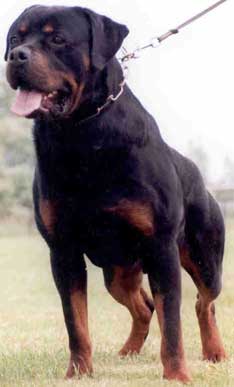
|

|

The origin of the Rottweiler is not a documented record. Once this is recognized, actual history tempered by reasonable
supposition indicates the likelihood he is descended from one of the drover dogs indigenous to ancient Rome. This drover dog
has been described by various accredited sources as having been of the Mastiff-type-a dependable, rugged, willing worker,
possessed of great intelligence, and a strong guarding instinct.
The transition from Roman herding dog to the dog we
know today as the Rottweiler can be attributed to the ambitions of the Roman Emperors to conquer Europe. Very large armies
were required for these expeditions and the logistics of feeding that number of men became a major consideration. No means
of refrigeration existed which meant that the meat for the soldiers had to accompany the troops "on the hoof." The services
of a dog capable of keeping the herd intact during the long march were needed. The above-described "Mastiff-type" was admirably
suited to both that job and the additional responsibility of guarding the supply dumps at night.
Campaigns of the Roman
army varied in scope, but the one of concern to us took place approximately A.D. 74. Its route was across the Alps terminating
in what is now southern Germany. Arae Flaviae, as the new territory was called, had natural advantages of climate, soil, and
central location. There is much evidence pointing to the vital role of the fearless Roman drover dog on this trek from Rome
to the banks of the Neckar River.
We have no reason to doubt that descendants of the original Roman drover dogs continued
to guard the herds through the next two centuries. Circa A.D. 260 the Swabians ousted the Romans from Arae Flaviae, taking
over the city. Agriculture and the trading of cattle remained their prime occupations, insuring the further need for the dogs.
About
A.D. 700 the local Duke ordered a Christian church built on the site of the former Roman baths. Excavations unearthed the
red tiles of Roman villas. To distinguish the town from others, it was then named das Rote Wil (the red tile), which
of course is recognizable as the derivation of the present Rottweil.
Rottweil's dominance as a cultural and trade center
increased unabated, and in the middle of the 12th century further fame and fortune came to it. An all-new town with elaborate
fortifications was built on the heights above the river. The security thus provided increased commerce in cattle. Butchers
concentrated in the area and inevitably more dogs were needed to drive the cattle to and from the markets.
The descendants
of the Roman drover dog plied their trade without interruption until the middle of the 19th century, at which time the driving
of cattle was outlawed; in addition, the donkey and the railroad replaced the dog cart.
The Rottweiler Metzgerhund
(butcher dog), as he came to be called, then fell on hard times. His function had been severely curtailed and in those days,
dogs earned their keep or there was no reason for their existence. The number of Rottweilers declined so radically that in
1882 the dog show in Heilbronn, Germany reported just one poor example of the breed present.
The annals of cynology
make no further mention of the breed until 1901 when a combined Rottweiler and Leonberger Club was formed. This Club was shortlived
but notable because the first Rottweiler standard appeared under its auspices. It is of value for us to know that the general
type advocated has not changed substantially and the character called for, not at all.
In these years (1901-07) the
Rottweiler again found favor as a police dog. Several clubs were organized as dissension was most common until 1921 when it
was agreed to form the Allegmeiner Deutscher Rottweiler Klub (ADRK). By that time, 3,400 Rottweilers had been registered
by three or four clubs. Duplications and confusion ended when the ADRK published its first stud book in 1924.
Since
its inception, despite the difficulties encountered during and in the aftermath of World War II, the ADRK has remained intact
and through its leadership enlightened, purposeful breeding programs have been promoted both in Germany and abroad.
|

|

|

